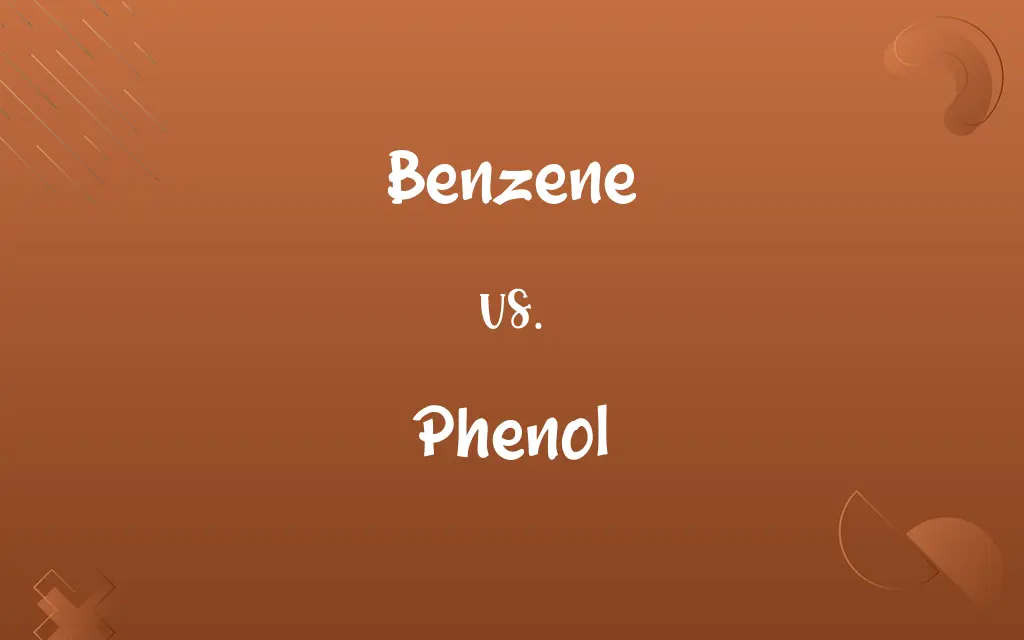Benzene vs. Phenol: Know the Difference

By Shumaila Saeed || Published on January 11, 2024
Benzene is a colorless, volatile, and flammable hydrocarbon with a distinct sweet smell; Phenol is a mildly acidic, white crystalline solid, derived from benzene, with antiseptic properties.

Key Differences
Benzene is an organic chemical compound with the formula C6H6, comprising six carbon atoms arranged in a ring with one hydrogen atom attached to each carbon. It is a fundamental compound in organic chemistry, used as a precursor for various chemicals. Phenol, on the other hand, is a derivative of benzene where one of the hydrogen atoms in the benzene ring is replaced by a hydroxyl group (OH), giving it the formula C6H5OH. This structural difference makes phenol distinct in properties from benzene.
Shumaila Saeed
Jan 11, 2024
Benzene is primarily used as a starting material in the synthesis of polymers, resins, synthetic fibers, rubber, dyes, detergents, and drugs. Its applications stem from its simplicity and symmetry in structure. Phenol is used in the production of plastics, explosives, and pharmaceuticals. Unlike benzene, phenol's hydroxyl group contributes to its ability to participate in more diverse chemical reactions.
Shumaila Saeed
Jan 11, 2024
Benzene is known for its carcinogenic properties and poses significant health risks if inhaled or absorbed through the skin. It's often used in gasoline and as a solvent in many industries. Phenol also poses health risks but is unique for its antiseptic properties. It's used in low concentrations in some medical and cosmetic products for its ability to kill bacteria and fungi.
Shumaila Saeed
Jan 11, 2024
Benzene is less reactive than its derivatives due to its stable ring structure, which undergoes substitution reactions rather than addition reactions. Phenol, with its hydroxyl group, is more reactive, especially towards electrophiles, and can undergo both substitution and oxidation reactions.
Shumaila Saeed
Jan 11, 2024
Benzene has a sweet, gasoline-like odor and is less dense than water. It is insoluble in water but soluble in organic solvents. Phenol has a distinct, sweet, and tarry odor, is about 1.07 times denser than water, and is moderately soluble in water due to its polar nature.
Shumaila Saeed
Jan 11, 2024
ADVERTISEMENT
Comparison Chart
Basic Structure
Hydrocarbon ring (C6H6)
Hydrocarbon ring with a hydroxyl group (C6H5OH)
Shumaila Saeed
Jan 11, 2024
Chemical Reactivity
Less reactive, undergoes substitution reactions
More reactive, undergoes substitution and oxidation
Shumaila Saeed
Jan 11, 2024
Physical Properties
Colorless, sweet smell, insoluble in water
White, sweet-tarry smell, moderately water soluble
Shumaila Saeed
Jan 11, 2024
ADVERTISEMENT
Benzene and Phenol Definitions
Benzene
Benzene is a colorless and highly flammable liquid.
In laboratories, benzene must be handled with care due to its flammability.
Shumaila Saeed
Dec 28, 2023
Phenol
Phenol is a toxic white crystalline solid with antiseptic properties.
Phenol was historically used as a disinfectant in surgeries.
Shumaila Saeed
Dec 28, 2023
Benzene
Benzene is known for its carcinogenic properties.
Long-term exposure to benzene can lead to serious health issues, including cancer.
Shumaila Saeed
Dec 28, 2023
Phenol
Phenol is a derivative of benzene with a hydroxyl group.
The presence of the hydroxyl group makes phenol more reactive than benzene.
Shumaila Saeed
Dec 28, 2023
Benzene
Benzene is used as a precursor in the manufacture of various chemicals.
Many plastics are produced using benzene as a starting material.
Shumaila Saeed
Dec 28, 2023
ADVERTISEMENT
Phenol
Phenol is used in the production of resins and plastics.
Phenolic resins are popular in the manufacture of countertops.
Shumaila Saeed
Dec 28, 2023
Benzene
Benzene is an aromatic hydrocarbon with a ring-like structure.
The smell of benzene is distinct and sweet, often noticeable near gas stations.
Shumaila Saeed
Dec 28, 2023
Phenol
Phenol can cause burns and is poisonous in high concentrations.
Industrial handling of phenol requires strict safety measures.
Shumaila Saeed
Dec 28, 2023
Benzene
Benzene is a natural constituent of crude oil, used in chemical synthesis.
Benzene is extracted during the refining process of crude oil.
Shumaila Saeed
Dec 28, 2023
Phenol
A caustic, poisonous, white crystalline compound, C6H6O, derived from benzene and used in resins, plastics, and pharmaceuticals and in dilute form as a disinfectant. Also called carbolic acid.
Shumaila Saeed
Dec 27, 2023
Benzene
A colorless, flammable, toxic, liquid aromatic hydrocarbon, C6H6, derived from petroleum and used in or to manufacture a wide variety of chemical products, including DDT, detergents, insecticides, and motor fuels. Also called benzol.
Shumaila Saeed
Dec 27, 2023
Phenol
Any of a class of aromatic organic compounds having at least one hydroxyl group attached directly to the benzene ring.
Shumaila Saeed
Dec 27, 2023
Benzene
(organic compound) An aromatic hydrocarbon of formula C6H6 whose structure consists of a ring of alternate single and double bonds.
Shumaila Saeed
Dec 27, 2023
Phenol
A caustic, poisonous, white crystalline compound, C6H5OH, derived from benzene and used in resins, plastics, and pharmaceuticals and in dilute form as a disinfectant and antiseptic; once called carbolic acid
Shumaila Saeed
Dec 27, 2023
Phenol
Any of a class of aromatic organic compounds having at least one hydroxyl group attached directly to the benzene ring (or other aromatic ring)
Shumaila Saeed
Dec 27, 2023
Benzene
A volatile, very inflammable liquid, C6H6, contained in the naphtha produced by the destructive distillation of coal, from which it is separated by fractional distillation. The name is sometimes applied also to the impure commercial product or benzole, and also, but rarely, to a similar mixed product of petroleum.
Shumaila Saeed
Dec 27, 2023
Phenol
A white or pinkish crystalline substance, C6H5OH, produced by the destructive distillation of many organic bodies, as wood, coal, etc., and obtained from the heavy oil from coal tar.
Shumaila Saeed
Dec 27, 2023
Benzene
A colorless liquid hydrocarbon; highly inflammable; carcinogenic; the simplest of the aromatic compounds
Shumaila Saeed
Dec 27, 2023
Phenol
Any one of the series of hydroxyl derivatives of which phenol proper is the type.
Shumaila Saeed
Dec 27, 2023
Phenol
Any of a class of weakly acidic organic compounds; molecule contains one or more hydroxyl groups
Shumaila Saeed
Dec 27, 2023
Phenol
A toxic white soluble crystalline acidic derivative of benzene; used in manufacturing and as a disinfectant and antiseptic; poisonous if taken internally
Shumaila Saeed
Dec 27, 2023
Phenol
Phenol is moderately soluble in water and has a distinct odor.
The smell of phenol is often described as sweet and tar-like.
Shumaila Saeed
Dec 28, 2023
Repeatedly Asked Queries
What is benzene?
Benzene is a colorless, volatile hydrocarbon with a sweet smell, used in chemical synthesis.
Shumaila Saeed
Jan 11, 2024
What are the uses of phenol?
Phenol is used in the production of plastics, explosives, and as an antiseptic.
Shumaila Saeed
Jan 11, 2024
What is the primary difference between benzene and phenol?
Phenol has a hydroxyl group attached to the benzene ring, altering its chemical properties.
Shumaila Saeed
Jan 11, 2024
Can phenol be found in household products?
Yes, in low concentrations, phenol is used in some medical and cosmetic products.
Shumaila Saeed
Jan 11, 2024
What are the environmental concerns with benzene?
Benzene is a pollutant and poses a risk to the environment, especially in water and air.
Shumaila Saeed
Jan 11, 2024
Is phenol used in medicine?
Yes, in low concentrations, phenol has antiseptic properties useful in some medical applications.
Shumaila Saeed
Jan 11, 2024
Is benzene dangerous?
Yes, benzene is carcinogenic and can be harmful if inhaled or absorbed through the skin.
Shumaila Saeed
Jan 11, 2024
How is benzene obtained?
Benzene is obtained from coal tar and as a byproduct of oil refining.
Shumaila Saeed
Jan 11, 2024
What safety precautions are necessary when handling benzene?
Use of protective equipment and ventilation is essential due to its toxicity and flammability.
Shumaila Saeed
Jan 11, 2024
Can phenol be used as a pesticide?
Historically, phenol was used as a pesticide, but this is less common now due to toxicity concerns.
Shumaila Saeed
Jan 11, 2024
What are the primary health risks of phenol exposure?
Phenol can be toxic, causing organ damage and skin burns upon exposure.
Shumaila Saeed
Jan 11, 2024
How is benzene disposed of safely?
Benzene waste requires special handling and disposal procedures to prevent environmental contamination.
Shumaila Saeed
Jan 11, 2024
Can benzene and phenol be used interchangeably?
No, due to their different chemical properties and reactivities, they have specific uses.
Shumaila Saeed
Jan 11, 2024
Why is benzene used in the manufacture of plastics?
Its chemical structure makes it a versatile precursor for various types of polymers.
Shumaila Saeed
Jan 11, 2024
Are benzene and phenol soluble in water?
Benzene is insoluble, while phenol is moderately soluble due to its hydroxyl group.
Shumaila Saeed
Jan 11, 2024
What industries commonly use benzene?
The petrochemical, plastic, and synthetic fiber industries commonly use benzene.
Shumaila Saeed
Jan 11, 2024
Is phenol biodegradable?
Phenol can be biodegraded under certain conditions, but it is generally considered a persistent environmental pollutant.
Shumaila Saeed
Jan 11, 2024
Can phenol cause skin irritation?
Yes, phenol can cause burns and skin irritation upon contact.
Shumaila Saeed
Jan 11, 2024
Is phenol naturally occurring?
Phenol can occur naturally, but it is also synthesized industrially.
Shumaila Saeed
Jan 11, 2024
How does the presence of a hydroxyl group affect phenol?
It makes phenol more reactive and gives it acidic properties.
Shumaila Saeed
Jan 11, 2024
Share this page
Link for your blog / website
HTML
Link to share via messenger
About Author
Written by
Shumaila SaeedShumaila Saeed, an expert content creator with 6 years of experience, specializes in distilling complex topics into easily digestible comparisons, shining a light on the nuances that both inform and educate readers with clarity and accuracy.








































































